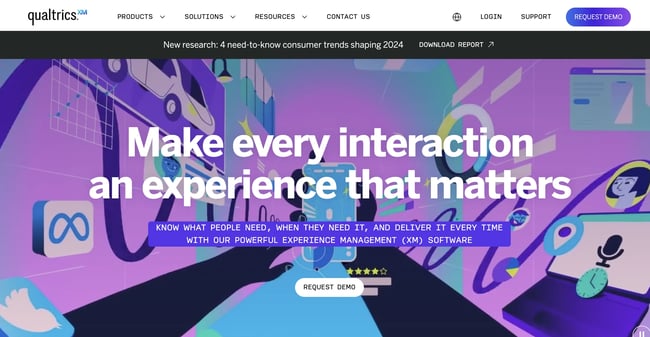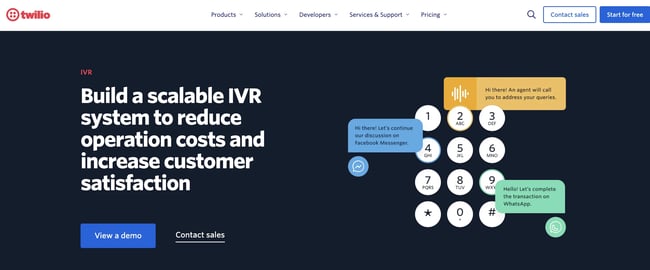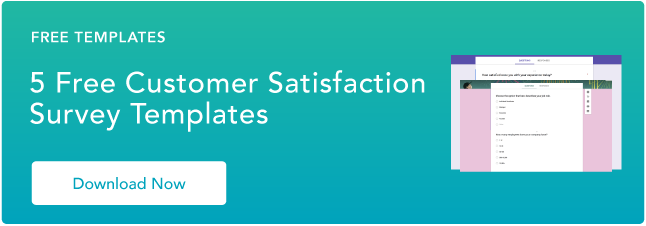I'm here to walk you through everything you need to know about automated phone surveys — from what differentiates them from CATI surveys, plus example questions, and the 10 steps you'll need to succeed. Finally, I'll share some of my favorite tools to help you create your own.
-
What are automated phone surveys?
Automated Phone Surveys vs. CATI Surveys
Know Your Audience — The Generational Phone Divide
6 Types of Phone Surveys and Example Questions
Building Automated Phone Surveys: 10 Steps to Success
Tools for Creating Automated Phone Surveys
What are automated phone surveys?
Automated phone surveys are a way to collect information from respondents over the phone. The survey itself is driven by a computer system that is pre-programmed with relevant questions and a logical flow of appropriate follow-up questions based on prior information provided by the respondents. Therefore, it's no extra lift for your team upfront.
Automated phone surveys typically use pre-recorded messages or text-to-speech technology to ask the questions. Yes/no and true/false responses are easily recorded for later reporting, and open-ended responses tend to be captured with a speech-to-text program.
That written information is then either reviewed by a human or crawled for keywords by the computer system to extract relevant data.
The last step is to analyze that data to find meaningful patterns or tally responses into useful statistics that empower your organization to make data-driven decisions.
Automated Phone Surveys vs. CATI Surveys
There are a couple of terms you may have heard on the topic of telephone interviews in general — CATI, computer-assisted telephone interview, and IVR, interactive voice recording.
CATI — Computer-Assisted Telephone Interview
CATI has been the technological bridge between humans calling humans and fully automated survey systems. In these surveys, a live interviewer has the CATI program open on the computer in front of them. The program helps to randomize the phone numbers and provides the interviewer with a way to record responses and organize them for later reports.
CATI surveys help humans conduct more streamlined surveys and track call duration as well. A good way to think of CATI is that you would use it when you need complicated human responses to open-ended questions as opposed to yes/no and true/false responses.
CATI surveys generally cost more because they require trained humans to spend time speaking with respondents one by one. A well-funded research team that wants to do a deep dive into opinions and experiences might choose CATI over IVR.
IVR — Interactive Voice Response, or Automated Phone Surveys
IVR surveys are fully automated, asking respondents to push numbers on their keypad or speak their answers into the phone. You're likely familiar with how they function, from dealing with pharmacy phone trees to verifying your personal information with the doctor's office.
These automated phone surveys can engage with a large volume of respondents in a shorter amount of time than CATI surveys, and they tend to be less biased. This is because there is no human element involved on the side of the interviewer that — knowingly or not — can lead the respondent to answer differently than they might have otherwise.
Sociocultural bending in human conversation happens all the time, often without notice. Attempts to be polite or give what the respondent perceives to be the morally 'right' or 'best' answers can lead to skewed results.
Automated phone surveys are great at collecting yes/no and true/false responses and are cost-efficient compared to CATI surveys. They are standardized, which is a double edge — they are less adaptable, but the responses are easier and faster to process.
IVR surveys are also referred to as robocalls , which reflects one of the few issues with this type of survey. Some consider them to be impersonal and may write them off.
Others mistake them for telemarketing calls. Many have had bad experiences with the technology when it was new, and they assume it will just be a frustrating waste of time — leading to lower participation rates.
Luckily, what jumps that hurdle is the sheer volume of respondents that can be reached. Lower participation rates among a high number of IVR surveys can be mathematically comparable to high participation rates in a lower number of CATI surveys.
Know Your Audience — The Generational Phone Divide
Something important to be aware of is that there is a generational divide in phone survey respondents, at least in the US. My experience matches the outcome of this TrackMage case study.
My Boomer parents are far more likely to pick up a ringing phone — any ringing phone at all, no matter whose it is. I assume this is because several families used to share one phone, so if you heard it ringing, you were obligated to pick it up and then let the right family/person know they had a call. They are much more likely to participate if a human conducts the survey because AI worries them.
If Gen Xers like my brother pick up, they will usually participate if you're clear upfront about why you're asking, keep it painless, and don't take too much of their time. You get one shot, so be real with them. They're a skeptical bunch, so lead with honesty and brevity. They don't have patience for sales games, flowery speech, or moving goalposts — they'll just hang up.
However, if you want input from Millennials and Gen Z, you're far more likely to catch us online, and you're far more likely to get a completed survey if we can do it on our own time. We don't want to be put on the spot with a random phone call, and we generally can't just drop what we were in the middle of to complete your phone survey.
If my phone rings and a name doesn't pop up, I know you're not friends, family, or contacts that were important enough to me to program in. So, leave a voicemail for us to review. If we agree that it's urgent/necessary/interesting, we will call back. Otherwise, we'll text you when we get a chance.
6 Types of Phone Surveys and Example Questions
The information you want to gather, the number and complexity of the questions required to get that information, and your budget typically determine the type of phone survey you'll want to choose. Our resident HubSpot research ninja, Pamela Bump, advises customizing your survey length based on your audience's typical attention span.
"You'll want to avoid survey lengths that might tire, confuse, or frustrate the user in order to avoid the possibility of them just giving random answers," she says.
Here are six common survey types followed by relevant example questions to help you determine what kind of survey may best suit the information you want to gather:
Customer Satisfaction
How many stars would you give for your overall satisfaction with the product?
-
Service?
-
Brand?
Customer Support Experience
On a scale of 1 to 5, how did your customer support representative do in terms of answering your question today?
-
Solving your problem today?
-
Taking care of your issue on the first call today?
Market Research
Did a social media influencer help you decide between two brands?
-
Follow-up [If yes]: Which social channel did you see them on — Instagram, TikTok, Facebook, or other?
-
Follow-up [if other]: Please say the name of the social channel where you saw this social media influencer.
Employee Engagement
Were you satisfied with the team-building exercises implemented by your manager this year?
-
Training opportunities provided this quarter?
-
The policy we have in place for parental leave?
Training Evaluation
Did you participate in the training opportunities provided this quarter?
-
Any time in this past year?
-
Follow-up: Did you find the course materials sufficient?
-
The instructor to be engaging?
-
Political Opinion
Do you plan to participate in the upcoming presidential election?
-
Senate race?
School Board meeting?
Building Automated Phone Surveys: 10 Steps to Success
There's a lot that goes into the design, implementation, and deployment of even the best automated phone surveys, not to mention analyzing and distributing the data at the end. Here are 10 steps to success when building your automated phone surveys.

1. Define your goals.
What information or insight are you attempting to gain? Who is your target audience? What survey length and question types will they best respond to so that your survey caters to their modus operandi ? Define these goals early — before you start creating your survey.
2. Choose your survey tool.
There is plenty of software available to purchase to help you run an automated survey. Or, you may opt to pay a subscription for access to software with automatic response capabilities. There are lots of online survey tools available, and we'll discuss several of them below.
3. Design your survey.
Make sure that you are creating a clear and well-structured questionnaire that flows smoothly from one question to the next. Hopping topics too abruptly can confuse the respondent, reducing their trust and the likelihood that they'll complete your survey.
4. Implement automatic response features.
The software program you use should have automatic response features that skip irrelevant questions based on previous answers. Some questions naturally require a follow-up question, requiring an automatic response feature called branching. These features ensure that respondents don't have to repeat themselves or try to answer irrelevant questions, causing them to bounce.
5. Decide on branding.
Automated phone surveys present branding opportunities that help control how your organization is perceived. If you need to include hold music, choose something that fits the vibe of your company. You may have several voice and accent options to choose from to literally act as the voice of your brand. Make it as on-brand as you can with the options available.
6. Pre-testing is critical.
It's critical to do a pre-test before deployment — and you are the most critical early tester. Checking back in with Bump, she encourages survey designers to take their own survey as a respondent:
"Preview the survey as if you're taking it for the first time after finding it on the channel it'll be promoted on. Not only will this ensure the survey and its features are working, but you'll also be able to put yourself in a respondent's shoes."
Bump adds, "Are you feeling tired, overwhelmed, or clicking random answers in a rush just to make sure it works? If so, that might be a sign it's not optimized for a full completion rate, or could result in inaccurate human-error results IF respondents DO make it through the survey."
After you make any necessary changes so that the survey fits your vision, have a small, trusted group of mentors and peers take your survey and provide input. It's best if you ask a few people who have varied personalities and ways of thinking/working. You want the most holistic, honest assessment you can get.
7. Focus on deployment.
Choose how you want to release the survey. Will you have your software randomly choose a number and dial it? Will you invite your mobile users via email to tap a button that connects them to the survey?
Always take your target audience into consideration. Do what you can to meet them where they are.
8. Monitor responses.
Most survey tools offer real-time analytics and reporting. It's best to keep an eye on things to detect major patterns. Are a lot of people leaving the survey on a particular question? Are the respondents skipping or ignoring the open-ended questions? There's plenty of data to learn from above and beyond their answers to your questions that may require you to pivot to get the results you were aiming for.
9. Analyze data.
Once enough respondents have participated, it's time to use your survey tool's analysis features — or export your data to a separate analysis tool. AI-powered analysis tools are especially efficient at finding patterns, interpreting the data, and drawing insights.
10. Share the results.
At long last, the results are in! It's time to prepare the infographics, write up summaries and conclusions, prep for presentations, and, above all — address insights with action plans.
4 Tools for Creating Automated Phone Surveys
Now that you know how to tackle making your automated phone surveys a success, let's run through five of the best tools you can use to make them.
1. Qualtrics

With Qualtrics Automated Phone Surveys, businesses can reach out to a broad audience and collect valuable data through interactive voice response (IVR) technology. IVR allows respondents to interact with the survey using their phones' keypads, responding to prompts, and providing feedback using touch-tone inputs.
Qualtrics Automated Phone Surveys also provide real-time data collection and analysis capabilities. Organizations can monitor survey responses in real-time. The platform also offers robust reporting and analytics tools, enabling businesses to identify trends more easily.
Best for: Complex logic structures and a huge variety of pre-loaded questions. This is a good option for larger companies that may have their own research branch and really lean into data.
2. Twilio

With Twilio Automated Phone Surveys, organizations can leverage Twilio's robust infrastructure and APIs to build and manage IVR systems. Users can design custom surveys, create branching logic based on responses, and dynamically adapt the survey flow.
Twilio's platform supports multi-language capabilities, enabling businesses to reach diverse audiences and gather feedback regardless of language preferences.
Best for: Omnichannel IVR in a consolidated platform for customer engagement solutions. Twilio can help you reach your customers wherever they are, even as you work in one integrated system.
3. Talkdesk
Talkdesk's platform offers a user-friendly interface that enables businesses to design and customize surveys easily. The solution supports many question types, including multiple-choice, open-ended, and rating scales.
Through intuitive workflows and integrations, businesses can automate the entire survey process. This includes initiating calls, collecting responses, and storing data seamlessly.
Pro tip: If you enjoy a lot of detailed report options, this may not be the tool for you. However, if you are a smaller outlet with less reporting to do and want an easy and intuitive drag-and-drop IVR flow builder, this is a good choice.
4. Plivo

Plivo offers a flexible and versatile platform for creating and conducting phone-based surveys.
Plus, this tool seamlessly integrates with other systems and tools, allowing for seamless data synchronization. Integration options with CRM systems or internal databases enable businesses to leverage survey data for holistic customer analysis and action.
Best for: Companies in the medical field. The tool makes a point of being HIPAA compliant, providing 99.99% reliability regarding downtime, and its customer satisfaction score on G2 is 98.
Getting Started with Automated Phone Surveys
In order to improve your offerings and reduce churn, you have to understand the needs of your user base. Automated phone surveys can help you do so, making the process of getting in touch with customers easy. Choose the right tool and get started making data-driven decisions today.
Survey Creation
.png?width=112&height=112&name=Image%20Hackathon%20%E2%80%93%20Horizontal%20(24).png)



![16 best free online survey makers and tools [+ recommendations]](https://53.fs1.hubspotusercontent-na1.net/hubfs/53/free-online-survey-maker-1-20251028-2654831.webp)


![How to conduct survey analysis like a data pro [all my tips + secrets]](https://53.fs1.hubspotusercontent-na1.net/hubfs/53/survey-results-1-20241031-6355381.webp)
![Leading questions: What they are & why they matter [+ Examples]](https://53.fs1.hubspotusercontent-na1.net/hubfs/53/leading-questions-hero.webp)
![How long should a survey be? The ideal survey length [New data]](https://53.fs1.hubspotusercontent-na1.net/hubfs/53/how%20long%20should%20a%20survey%20be_featured.png)



